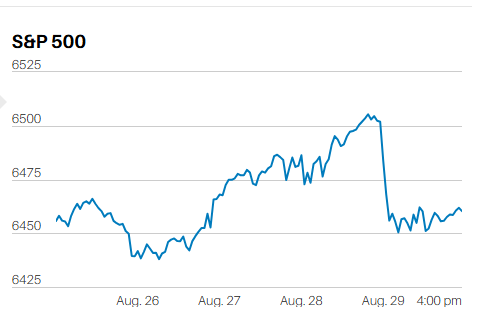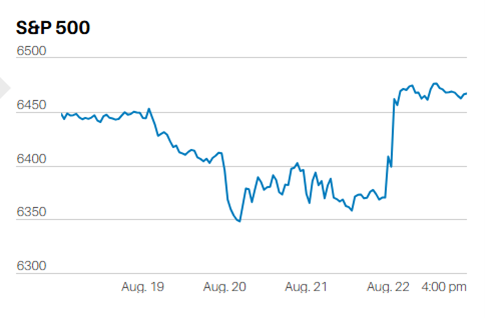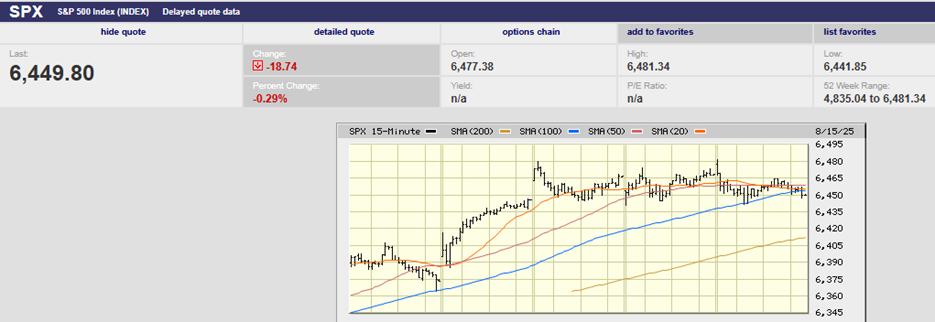Rate hike guaranteed on July 27th

Market Update
The S&P 500 rose 1.9% last week to finish at 3899.38. The Nasdaq climbed 4.6% as many of the most beaten-down tech stocks caught a bid. There is growing hope that the stock market may have found a bottom. It is unlikely. The S&P struggled with 3920 on Friday. We wrote last week, “We may see another attempt at the 3945.86 high following the 4th of July weekend. An advance past 3945.86 clears the way for a test of resistance at 4177.” Until we clear 4177 the short-term trend is down. The index needs to push through 3945.86 first. The 50-day moving average is next up at 3975. The S&P will struggle over the next few weeks as earnings season brings disappointment. The most likely outcome of earnings season is a test of the June 17th low at 3636.87 as either earnings or guidance disappoints.
The CME FedWatch tool shows a 100% chance that the Fed will hike 0.75% on July 27th. It also shows a 100% chance of at least a half-point hike in September. The Atlanta Fed GDPNow forecast is for negative 2.1% growth in the economy in Q2. It is a near certainty that earnings growth will decelerate in the second half of 2022. The S&P 500 has struggled when interest rates are rising, and earnings growth is slowing. The S&P has returned 1.7% per quarter with a 43% chance of a loss when interest rates are rising and earnings growth is slowing, according to Richard Bernstein of Richard Bernstein Advisors.
Earnings estimates are too high, and earnings season starts this week. The consensus is for 11% growth in 2022, according to Barron’s. The S&P 500 may actually see less than half of that for the year. Citigroup strategist Robert Buckland is forecasting growth of between 0% and 5%. Ed Yardeni of Yardeni Research is expecting 3.1% earnings growth for 2022. He is forecasting negative earnings growth in Q3 and Q4. Meanwhile, the consensus is for Q2 earnings growth of 4.9% followed by double-digit increases in Q3 and Q4. It is unlikely that earnings growth will reaccelerate into double digits in the second half of the year.
The stock market is more likely to see more downside testing over the next few months. Earnings season will give us a good read on how 2022 will finish up. Expect a test of 3636.87 in the next few weeks. Bear case downside for the S&P 500 for 2022 are lows around 3200 to 3300. Base case is for a year-end number around the current level. A reasonable bull case target (Fed pauses) could see the S&P 500 back to 4,000 - 4200.
Economic Indicators
The labor market remains strong. Initial jobless claims were 235,000 versus 231,000 last week. The nonfarm payroll number was much higher than expected at 372,000. Consensus was for 250,000. Average hourly earnings rose 0.3% in June. There are 11.3 million job openings in the U.S. with less than 6 million unemployed workers.
Manufacturing and service numbers remain solid. Factory orders in May rose 1.6% up from a 0.7% increase in April. The S&P Global U.S. services PMI logged 52.7 in June up from 51.6. The ISM services index was 55.3% in June down from 55.9%. Anything over 50 indicates growth. Mid-50s is solid growth.
Some storm clouds are racing our way, though making a recession in the next 6 months probable. Purchasing power is falling. Household wealth has taken a sizable hit. The cost of capital is rising for businesses. All of which makes it likely that demand will slow over the next few quarters. Meanwhile, analysts have earnings growth accelerating into double digits in Q3 and Q4. It would be quite a feat if aggregate profits growth accelerated in the second half of 2022 even as the economy was slowing. That hasn’t happened since at least the late 1940s, according to Barron’s.
Myopic Loss Aversion
It’s been a tough year for anyone using mutual funds, which is almost everyone. Bond funds are down 10% or more. Stock funds are down as much as 20%. Retirement plan participants invested in the most conservative target-date funds are down 10% or more in some cases. I’ve gotten several calls from 401(k) plan participants wanting to know what to do. I got another one last week.
The participant is 56 years old and invested in the Fidelity Freedom 2035 target-date fund. The fund is down 17.96% year-to-date. It has 38.5% of its assets in U.S. stocks and 37.4% of its assets in foreign stocks. Bonds make up 20.2% of the portfolio with the rest in cash. It is a typical Growth & Income portfolio which should average around 7% annually over a business cycle. The 401(k) participant was anxious and wanted to know what he could move to that would stop the losses.
I told him cash is the only way to guarantee against investment losses. I added that cash would cost him as well though. Or more accurately cash would lose its purchasing power because of inflation. At 8% a dollar will only buy you 92 cents worth of goods and services a year from now.
I also told him I didn’t recommend moving to cash since market timing doesn’t work. How much doesn’t it work? Well, from 1980 through 2020 you’d have missed out on approximately $884,000 in returns if you missed the 50 best trading days. Oh, and that’s on a $10,000 investment. Let that sink in for a moment. According to Fidelity a $10,000 investment in the stock market in 1980 would have grown to $952,000 by the end of 2020. It would have only increased to $68,000 if you missed the 50 best trading days.
Myopic loss aversion causes us to make bad decisions. Myopic means near-sighted. Loss aversion is our desire to avoid losses or bad outcomes in life. The participant who called me was focusing on his losses in 2022 and forgetting about his prior gains. The Fidelity Freedom 2035 fund returned 25.75%, 16.39%, and 13.90% in the prior three years.
In fact, he is still up 36.8% over the trailing 3 ½ years. Assuming he breaks even in the second half of 2022, he’ll still have earned 9.2% annually over a four-year period. A 9.2% return is what you’d expect out of a 100% U.S. stock portfolio, not a well-diversified stock and bond portfolio. In other words, he's doing very well. He decided to stay where he was by the end of the phone call.
Due Diligence
I had a meeting with a husband and wife who are thinking about leaving their current advisor. They need to leave. Their current portfolio is expensive, chock full of front-loaded mutual funds. It is also over-diversified, containing dozens of mutual funds, ETFs, and stocks. More than 125 holdings. It is effectively a very expensive index fund but without a true index fund’s precision. For example, Microsoft was held in 13 different investments in the portfolio.
Investments that own the same securities do nothing for diversification. Rather, it makes it hard to know how much exposure you have to any particular stock. Knowing what and how much you own is the number one rule of investing. You can't manage risk if you don’t know what and how much you own. The prospect's portfolio is one of the worst I've seen in a long time. It is expensive and there are far too many investments in it, many overlapping.
The meeting was also memorable for the questions one of the spouses was asking. They were excellent questions. She wanted to know how much we charged. She wanted to know how we got paid. She wanted to know how our fees compared to her current advisor’s fees. Great questions that most prospects never seem to get around to asking.
She also wanted to know how Norwood Economics would invest their money. In particular, she wanted to know how the decision-making process worked. For instance, would I buy and sell on my own or talk with them first? (We typically make the investment decisions autonomously unless asked not to do so). What control did they have over the investing? (We agree on the asset allocation and Norwood manages to that allocation). There was more but you get the drift.
All in all, it was an excellent discussion of the specifics of our advisor/client relationship. It was a nice change that she was driving the conversation. More people need to take more time understanding: how their advisors get paid; how much their advisors get paid; what their advisors should be doing for the money; and how their advisors will invest their money. Unfortunately, many people neglect to do their research.
Regards,
Christopher R Norwood, CFA
Chief Market Strategist











